Scratch Remote Guardian Probe Jinx 1.2 Original Design / Scratch Built
Scratch - Remote Guardian Probe Jinx 1.2 {Scratch}
Contributed by Les Bradshaw
| Manufacturer: | Scratch |
Brief:
This is for the Box of Parts contest Well, this rocket for me has had multiple problems, hence the “jinx”
name. Part of the issues was good old procrastination. But, excessive work schedules (a few weeks where I was averaging
70 hours a week), stuck tubes, a crashing computer that lost my files, and crashing rockets (more about that later)
– but it finally flew successfully! The parts arrived late March. Like a kid giddy at Christmas, I opened the box,
and was surprised by the amount of stuff!
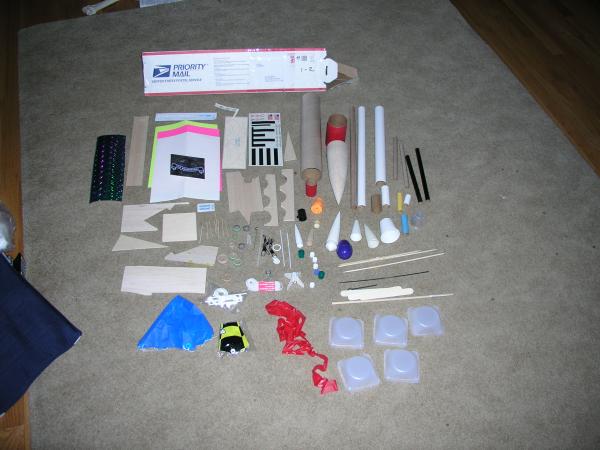
Construction:
The parts that I used are listed below:
- 1 – BT80 x 14 ¼” tube
- 1 – BT55 x 13 ½” tube
- 1 – BT50 x 18” tube
- 1 – BT50 x 3 ¼” tube
- 1 – BT20 x 18” tube
- 1 – BT20 x 3” tube
- 1 – BT19 x 3” tube
- 2 – BT5 x 9” tube
- 2 – BT5 x 7 ½” tube
- 1 – BT80 x 4” coupler
- 2 – BT55 x 3” couplers
- 1 – 80K balsa nose cone
- 1 – BT55 x 5 ½” plastic nose cone
- 2 – BT55 x 3” broken plastic nose cones
- 2 – BT20 x 2 ¾” nose cones
- 1 – BT20 x 1” fiber nose cone
- 3 – BT20 ~ BT50 adapters
- 1 – BT50 ~ BT60 adapter
- 1 – plastic cup
- 3 – measure/mix cups
- 2 –large plastic caps
- 5 – small plastic caps
- 1 – BT5 fin can
- 1 – dual display nozzle
- 2 – 12” parachutes
- Misc 1/8” balsa
- Misc 1/16” balsa
- 1 – fin
- 3 - snap swivels
- 2 – engine hooks
- 1/8” launch lug
- 7 – toothpicks
- ¼” dowel
- 2 large skewers
- 3 small skewers
- Paper
- Decals
- Holographic sheet
- Mailing box
The first thing I did was to weigh the parts. My goal was to use as much as possible. Based on the weight, I decided that the rocket would need a cluster of 2 D engines to fly. I also felt the amount of balsa wood was a bit skimpy (but as I actually got into the build, it appeared that whenever I needed some wood, there was still a piece available).
During the rest of the build, you will find me referring to version 1.1 and version 1.2. What should be obvious, I first built version 1.1. First flight was at NERFF 4 and the rocket crashed, causing some major damage. JINX! To keep with only using what came in the box, I repaired and updated the design to version 1.2. The second launch also crashed. JINX! But at least not as bad.
During the development, I made up various pieces and taped them together, giving me some flexibility to adapt the design. Below is a teaser of the taped up version. You will also see where I filled spirals using Elmer’s F&F.
I was tempted to fly it, but I could not figure out
1. What the speed of masking tape was
2. How to convince an RSO to launch it
3. How many pieces would it be in after a flight
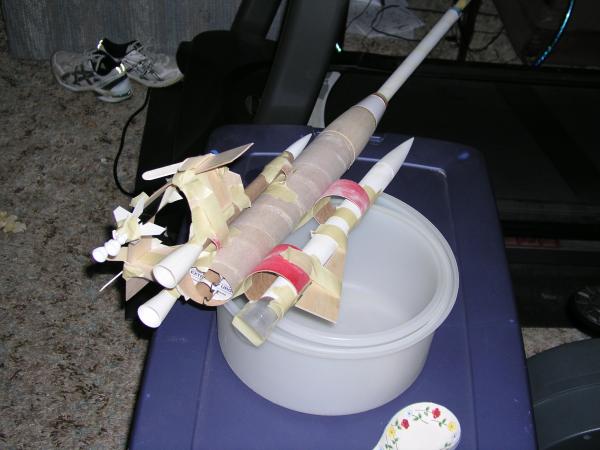
For version 1.1, one of my first steps was to boil some corn (although clams or any other food would work as well – or just plain water). Once the water was boiling, I placed the 1/16” strip of balsa (it was 2” x 12”) across the pan. Besides satisfying my hunger, I was also steaming the wood so I could bend it. The corn was done first so I had to keep steaming the balsa but I finally removed the balsa and sandwiched them between 2 of my wife’s cake savers (one is 10” the other is 12”). WARNING – that last step can get you into trouble!! I let this sit for a while (over a day) for the balsa to retain its shape
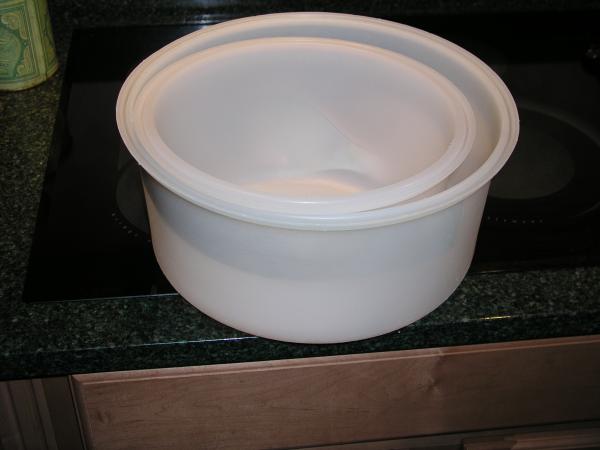
I decided on using the BT80 as my main tube, with 3 pod tubes off of this main. I wanted to use the couplers to hold these pods. Take the 3 couplers (1 BT80 and 2 BT55) and draw lines the length of the coupler on opposite sides (180 degrees apart). For the BT80, make a mark at 2” on one line and a mark at 1” on the other. For the BT55, make the marks at 1” and ½”. Using stiff paper, connect the marks on both sides. Using a sharp knife, cut along these lines.
Some other preparation work – take one of the 9” BT5 tubes. Make a mark 4.5” down from one end. Cut the tube using this mark as the center on an angle, ¼” above and below this position. Epoxy a large plastic cap to the straight end of each tube.
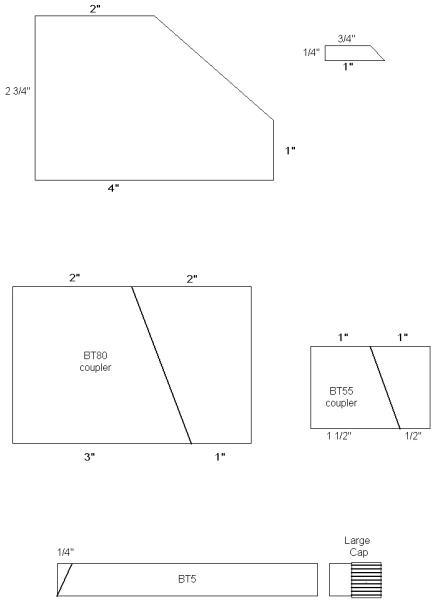
In addition, cut out 2 each of the 2” x 2 ¾” x 4” x 1” fin and the ¾” x ¼” x 1” pieces shown above
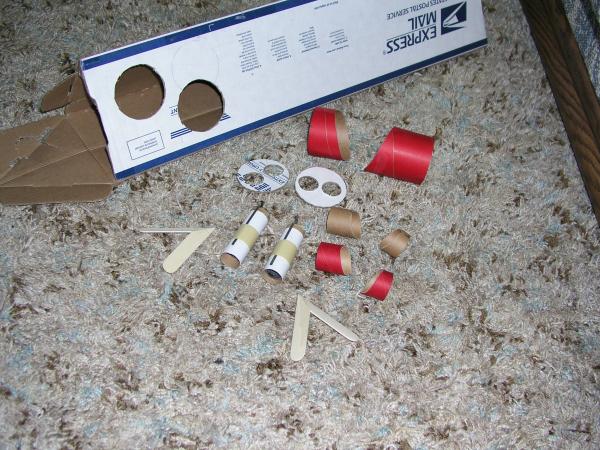
For the motor mount, I traced the BT80 onto the mailing box and cut out the circle. Then I drew a line that went through the center. On here, I traced 2 circles, centered on the line but the edges separated by about 1/8”. I cut out these holes and dry fitted the piece into the BT80 and the BT50 tubes into the center circles. Sand to fit. Once satisfied, I used the first piece as a template and made a second piece. The two BT50 motor tubes had a 1/8” slit made 2 ½” from one end. Insert the motor hook and secure with tape. Slide the motor tubes into the two centering rings. Cut another piece of cardboard 2” x 2.6” Glue the 2 motor tubes to the centering rings, sandwiching the 2” x 2.6” cardboard between the motor tubes and the rings. Let dry.
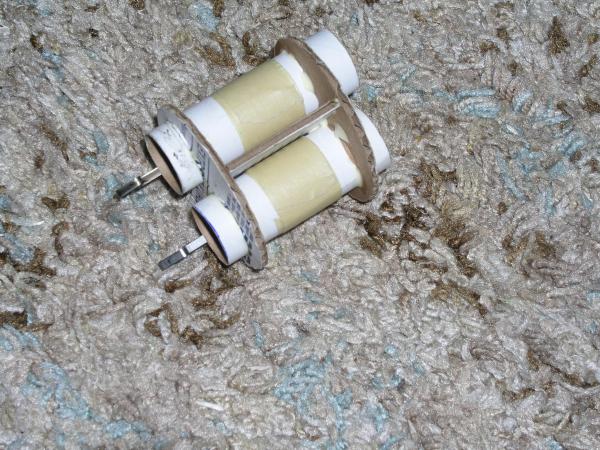
Take the other 2 tongue depressors and make a mark 2 ½” from each end on the edge. Draw a line connecting the marks. Cut the tongue depressor apart on this diagonal line. Bevel the cut edges and glue the pieces back together to create an angle. Glue a toothpick into the angle created.
For version 1.1, I made some standoffs. Cut 4 pieces of balsa ½” x 1 ¼”. Bevel one of the 1 ¼” edges on each piece. Glue the pieces together so the bevels create a “V” channel
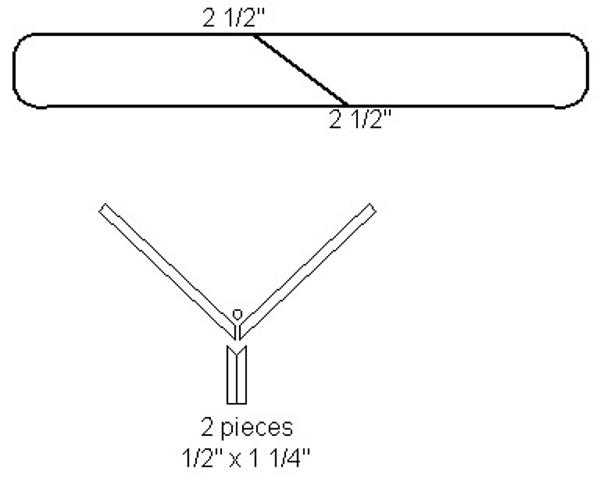
While the version 1.1 was designed for a 3/16” rod, the rocket was too heavy. The version 1.2 was upgraded for ¼” rod. Since all I got was 1/8” launch lug material, I had to improvise. Take 3 of the small skewers, cut 2 to 7” and the third to 9” from the pointed tip. Save the cut off ends for future use. Glue the two 7” skewers to a tongue depressor even with the ends. Let dry. Cut the ¼” dowel into two 6” sections. Glue these to the 7” skewers. Finally, the 9” skewer needs to be glued in the middle of the tongue depressor on the opposite side.
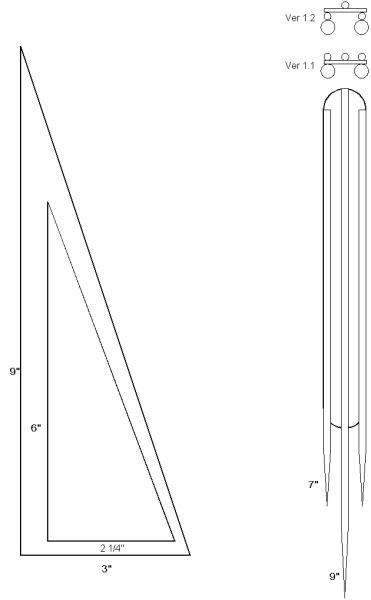
From the 1/8” balsa, cut 2 fins 9” x 3”. I received a plywood fin that was already 6” x 2 ¼”. You would need to cut your own fin out.
The BT80 section needs to be lengthened for stability, so I transformed the 80K nose cone into a transition. For version 1.1, I planned to eject the parachutes from the very top, but I ran into issues. Version 1.2 separates at the transition. First, take the plastic cup and cut about 1 1/8” diameter hole in the top. Slide the cup over the nose cone end. Adjust the hole size until the edge of the cup (with the lip) is snug on the nose cone. Carefully, cut away the trim, double check the fit, then glue the cup over the nose cone. Let dry.
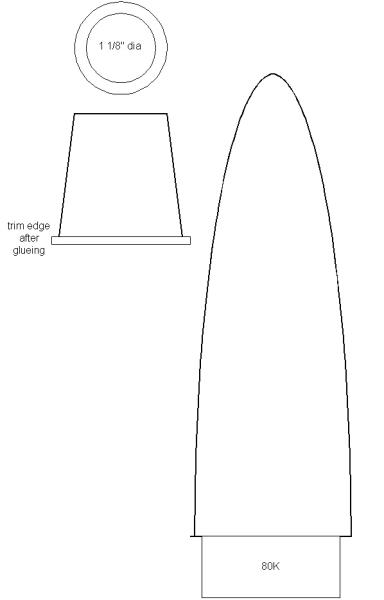
This is how it looks when done
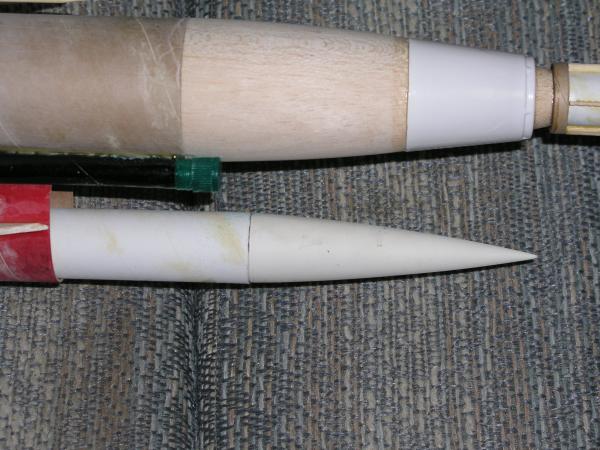
To attach the top to the nose cone, take one of the BT 20 to BT50 adapters and place it over the top of the 80K nose cone. Mark where it touches the cone and remove it. Take the BT50 tube. First cut off a 3” length (to use as a motor mount). Slide a BT50 section over the nose cone end. Again, mark where it touches. Dry fit the BT20 to BT50 adapter in the 15” length and the BT50 to BT60 over the same end. Push the tube and adapters onto the nose cone and verify the fit. Once you are satisfied, slide the BT50 to BT60 adapter up a bit and remove the BT20 to BT50 adapter. I used 30 minute epoxy; put some inside the BT50 tube followed by the BT20 to BT50 adapter. Place more epoxy on the outside of the BT50 tube near the end. Finally, place more epoxy on the nose cone at the marks made earlier. Place the tube over the end of the nose cone and press down. This will push the BT20 to BT50 adapter up, and slide the BT50 to BT60 adapter down. Make sure the tube is straight with the nose cone. Let dry.
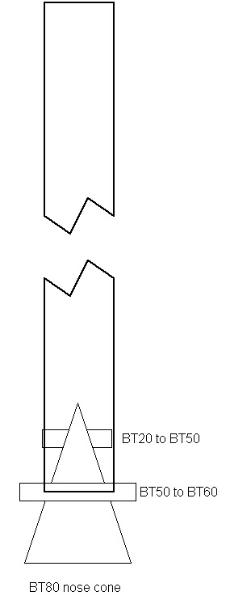
While the transition section is drying, you can make the nose cone section. Take the 3” BT20 tube and 4 equally spaced lines (every 90 degrees) along the length of the tube. From one end, make marks at 1” on two opposite lines, and marks at 1 ½” on the other two opposite lines. Similar to the couplers, connect the marks and carefully cut the tube. Take the BT19 tube and make 2 lines the length of the tube on opposite sides.. I am not sure if BT19 is a real designation. (This tube is one you would normally get with an Estes rocket, make a mark, put glue inside a motor tube, and use this tube to push the motor block in up to the mark, and then “quickly remove to keep from getting stuck”).
One piece of the BT20 will be slightly smaller. This is the top. Glue it onto the BT19 lining up the pointed ends with the marks on the tube. Glue the 1” BT20 nose cone onto this end. Glue the other BT20 section onto the BT19, also lining up the pointed ends. Glue 2 BT20 to BT50 adapters onto this end. I put the first on so it only left a small 1/16” ~ 1/8” of the BT20 extending, so the adapters are mostly glued to each other
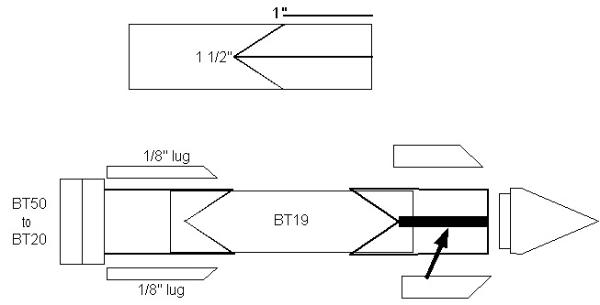
Since the 1.1 version was to be the separation point for ejection, I did not want this nose to slide down, so I created a lip by cutting 2 launch lug sections, with the tops cut at an angle, to the BT20 tube in line with the pointed ends. The 2 balsa pieces cut earlier (¾” x ¼” x 1” pieces) were glued to the top on the shorter portion, 90 degrees from the launch lugs.
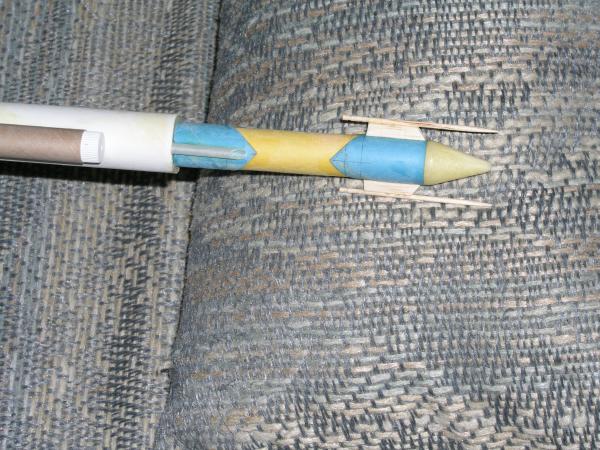
I glued 2 toothpicks as antenna, but they quickly broke off. I would not bother.
Once the top was dry, to ensure stability, I added 1.5 ounces of epoxy and BB pellets to the top.
The wing pods can start assembly. Cut the 18” BT20 in half. Draw a line along the length of the 2 pieces. Make marks at 2 ¼” and 7” from one end. Glue the 2 BT55 couplers cut before at the 2 ¼” and 7” locations. Note the positions of the smaller and larger coupler segment and the direction of the angled cuts. Make 2 of these. Glue the BT20 x 2 ¾” nose cones in. Using a Dremel tool, I cleaned up the ends of the broken BT55 nose cones. These I epoxied into the other end to look like a nozzle. I canted the nozzle for appearance. Let dry, then glue the 2” x 2 ¾” x 4” x 1” fin to the other side. You should cut a notch into the fin to fit over the coupler.

Back to the main section, I slid the larger BT80 coupler into the BT80 tube with the point even with the end. I used this as a marking template to cut the BT80 tube. I then spent an hour trying to get the coupler out of the tube, causing me to have to cut ¼” strip off where a chewed it up trying to push the jammed thing out. JINX! Cut out the BT80 tube at the mark.
I used a piece of paper and marked the paper to determine the BT80 circumference. Sorry for changing units, but I found it to be almost exactly 21 cm. I wanted the wings pods to be slightly asymmetrical, so for 3 pods they should be 7cm apart, instead I used 6cm. for the 2 wings. I centered the point with the 6cm marks on the point of the BT80 tube and marked the tube. Extend these lines the length of the tube. Glue the motor mount into the BT80 so the 2 tubes are perpendicular to the point.
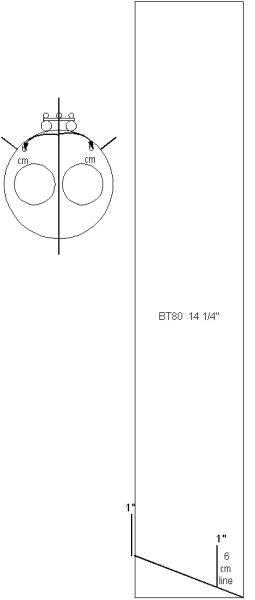
Since my motor mount was cardboard, I did coat it with epoxy for protection.
Glue the launch lug assembly so the rear of the dowel is 4” from the end of the BT80 tube.
Glue the wing pods to the BT80 so the rear of the wing coupler is 1” from the end of the BT80 tube on the 6cm lines.
Thee rudder pod is similar to the wing pods. Mark and glue the BT80 couplers to the BT55 tube at 2 ¾” and 9 7/8” positions. Glue the smaller fin to the coupler and body tube (you will need to cut a notch into the fin for the coupler) as shown.
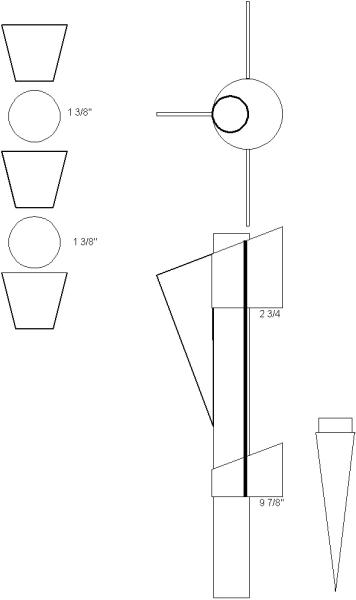
The 2 large fins should wait until this is glued to the BT80 tube. Mark and glue this pod to the BT80 tube, again with the end of the coupler 1” from the end of the BT80 tube. To assist in the stability, glue the left over segments of the skewers (from the launch lug) between the rear BT80 coupler and the BT80 tube. The 4 ½” BT5 tubes glue between the front coupler and the BT80 tube, aligning the angled cut with the coupler. Glue the BT55 nose cone to the front.
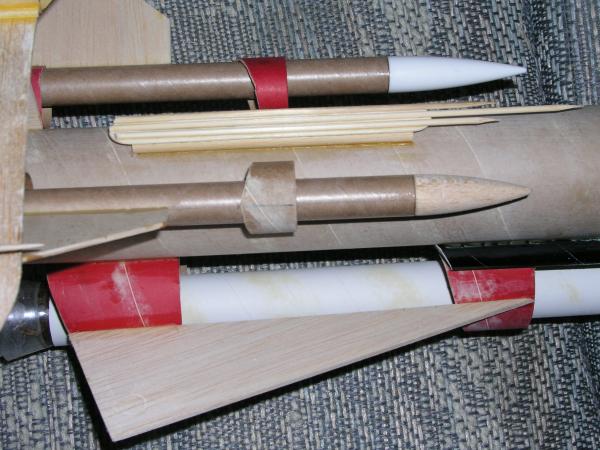
Once dry, glue the larger fins between the coupler sections on either side. To make a nozzle for the rudder, I sanded and roughed up the 3 measuring/mixing cups. I cut 2 circles (1 3/8” diameter) from the mailing box. I beveled the edge, and then glued one circle into 2 of the cups, then glued the cups together (all using epoxy). Once dry, this glued into the rear of the BT55 tube. This nozzle I left straight.
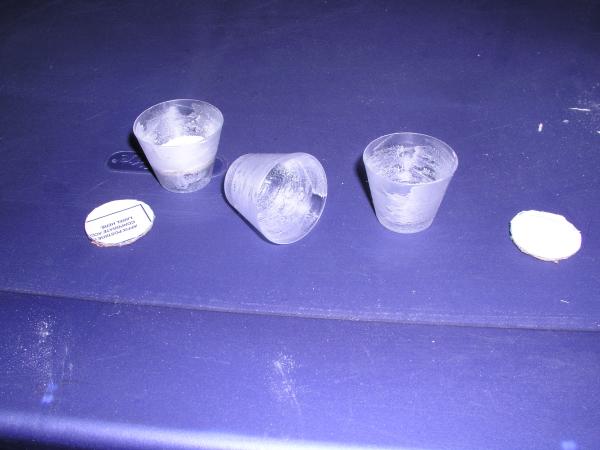
Now to complete the top. Starting at the BT50 to BT60 adapter, glue 2 large skewers and 2 toothpicks along the tube. Attach two of the 7” BT5 tubes in line with the toothpicks starting at 9” from the top of the BT50 tube. Glue small plastic caps to the top of these tubes. Glue the nose assembly to the top. The launch lugs should be in line with the BT5 tubes

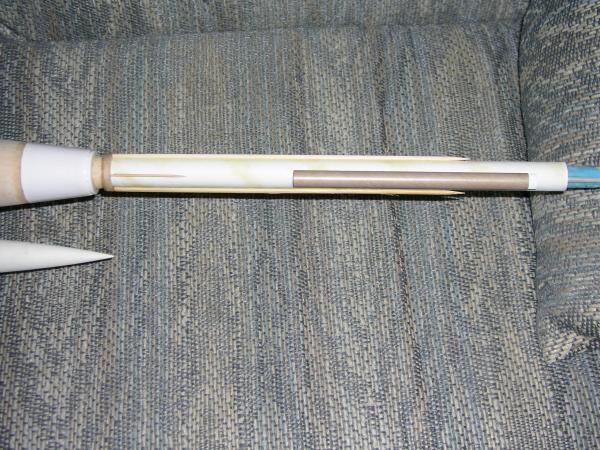
The shock cord was cut in half. A provided screw eye was attached to the 80K nose cone. I used some of the paper to make a trifold to attach the shock cord to the main tubes. Using the snap swivels, one 12” parachute was attached to the top and the other was attached to the main tube shock cord.
For version 1.1, the bent balsa was attached to the fins on the wings. The V beveled standoffs were attached over the wing fins. A missile was made using the last BT5 tube, the fin can, the display nozzle, and another small cap. A missile rack was made with some ¼” x ¼” x 2” supports. Finally, two 1” x 3” supports were made to support the missile. Your size may vary based on the size of your wife’s cake savers (or other molds you may have used).
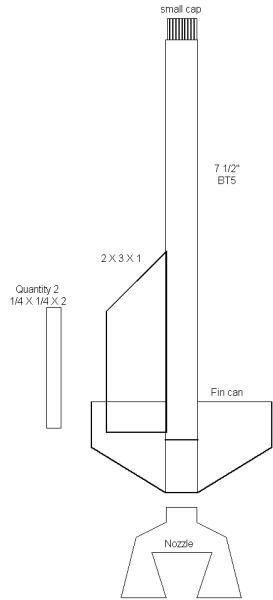
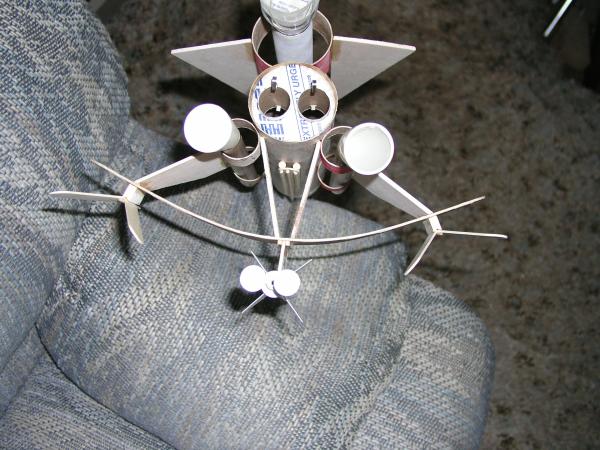
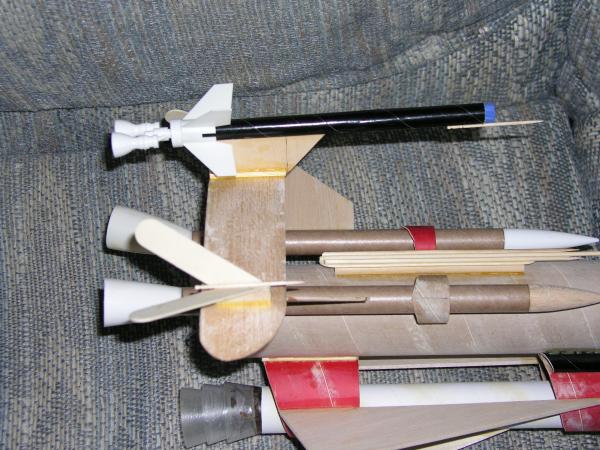
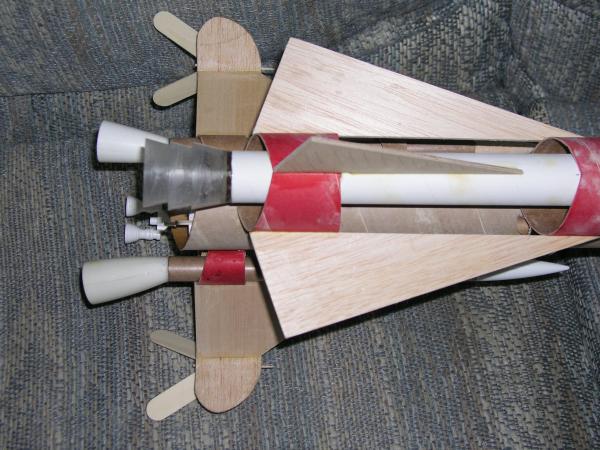
Flight:
Cutting things to the wire, the night before I left for NERRF I’m giving this thing a quick primer coat and 1
coat of white. There were supposed to be chances of thunderstorms at NERRF and I was afraid the field could be wet.
Water and cardboard don’t mix. So, on Saturday, off to NERRF 4 I went to fly the beast. As I previously stated,
the rocket was designed to eject the parachutes from the top (I did not discuss about the holes I drilled through the
80K nose cone. As I was prepping the rocket, I noticed the parachutes were tight. This had me concerned. I had not
glued the 80K to the BT80 (fortunately), so I taped this joint. Installed 2 D12-3 engines and got through the RSO (he
did wince when I stated it only used two 12” parachutes). While waiting to load, I had several comments asking how
I kept all the small pieces on. I explained this was its first flight. We called a heads up flight.
They launched the HPR rockets, started the LPR – and stopped halfway! They then went to more HPR and did not come back to the LPR. My rocket sat on the pad for over an hour. JINX! Finally, it launched. It danced a bit on the pad – the rocket weight was really too heavy for a 3/16’ rod. Also, I thought the 3/16” rods were 4’, but they were only 3’. But, the rocket went up nice and straight. But those tight chutes did not come out. The tape at the transition let go – crash. JINX!
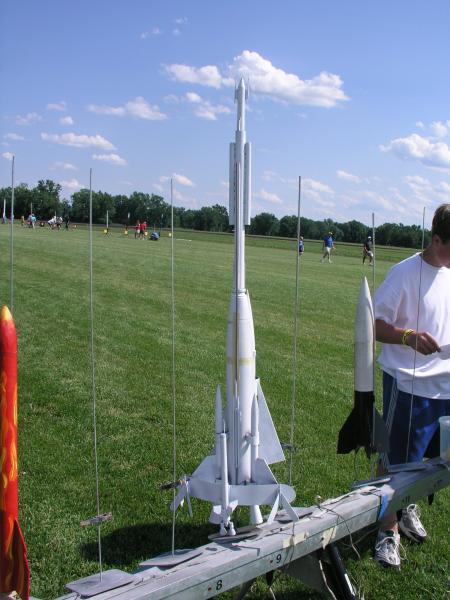
I gathered up the pieces. The worst damage was the wing. At least the corn had tasted good.
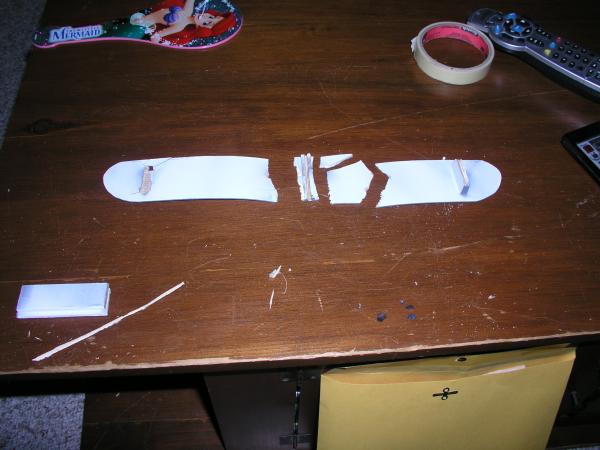
As I previously stated, at this point I cut off the 1.1 version of the launch lug and rebuilt it as version 1.2. I decided the missile added too much weight, and I had no good place to put it, so I left it off. I cut off the standoffs for the tongue depressors and mounted them upside down. It was also at this point when I changed to the shock cords to connect at the transition. So, I went back to NERRF on Sunday. While loading the engines, I had the rocket leaning against the side of my car. I had to grab something, and it fell over and cracked a fin. JINX! A quick glue repair and it was good to go. I did not have to wait this time, possible since I was now on the ¼” rods. Again, I requested a heads up. It launched beautifully straight, but when the chutes came out the one for the main section tangled on the launch lug skewers and landed hard. JINX! But at least the top came down gently, and landed in one of the water filled irrigation ditches. JINX! JINX! JINX! Fortunately, it was only the very tip with the epoxy/BB filling. There was some minor damage to the rocket, but it was repairable. I was going to give up, but then the contest got extended a week, just enough time for some repairs and painting.

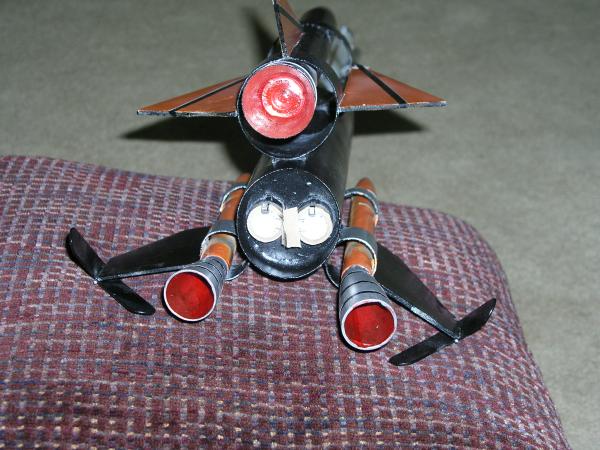
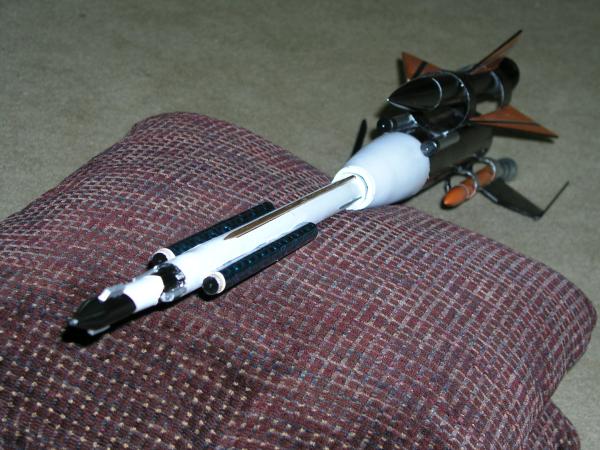
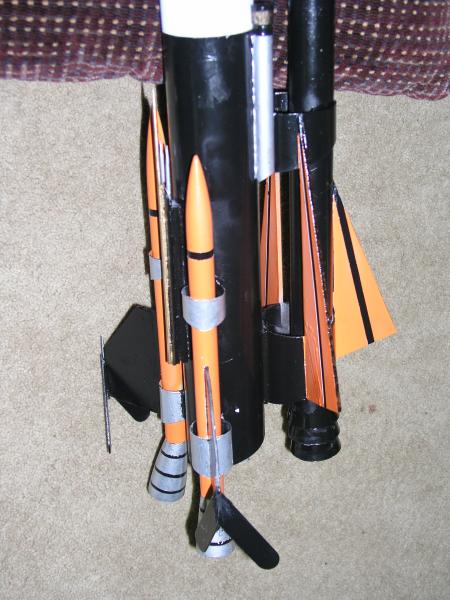
My son and I went to a local school yard and did 1 launch. Nice and straight, both chutes opened, and a safe recovery! I was not going to tempt fate with another launch. One thing I would say, the rocket really needs 18” chutes minimum. While the landing did not cause any damage, I did wince as it looked rather hard. However, I had to live with what I got – the 12” chutes.
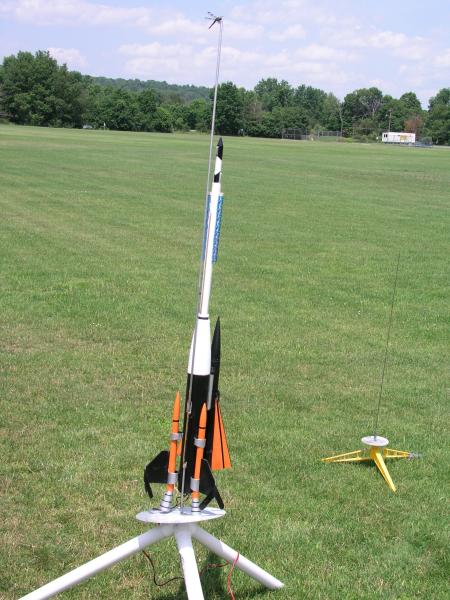
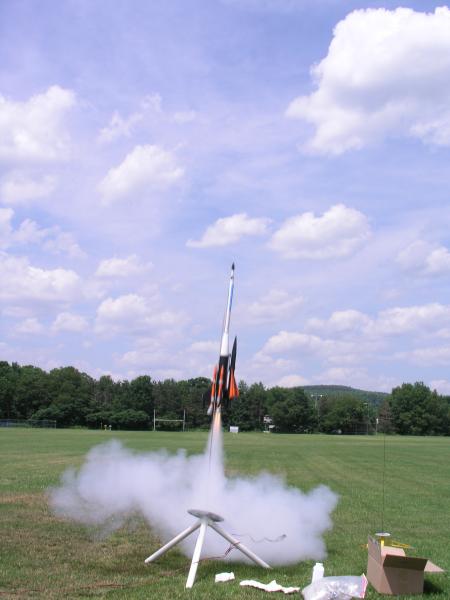
Summary:
This was a great contest that challenged me. Despite all my JINXes, I think I came up with something special that
used almost all of my parts. I guess the only thing I didn't try is putting the rest of the parts into a blender...
Sponsored Ads
 |
 |











